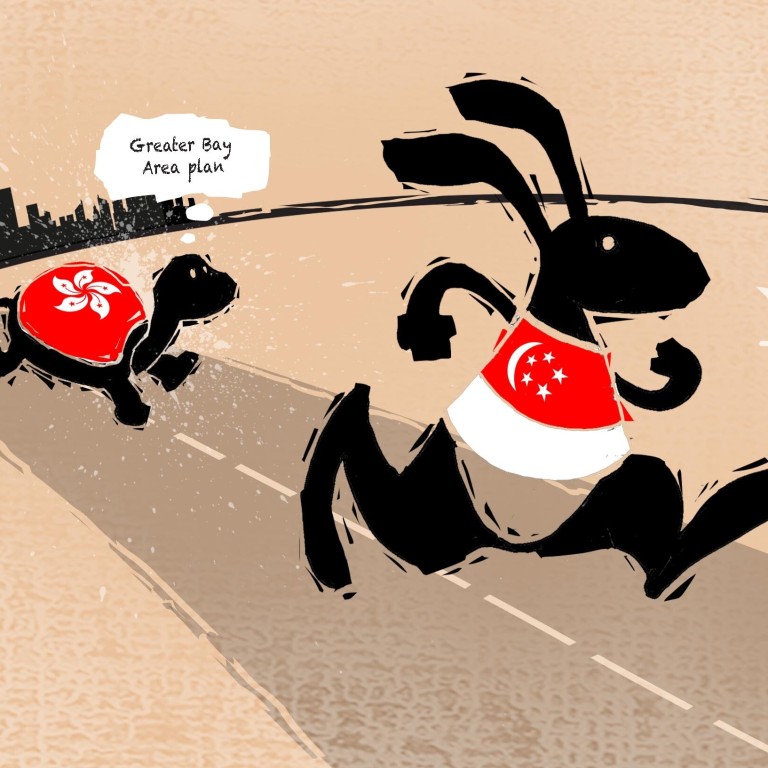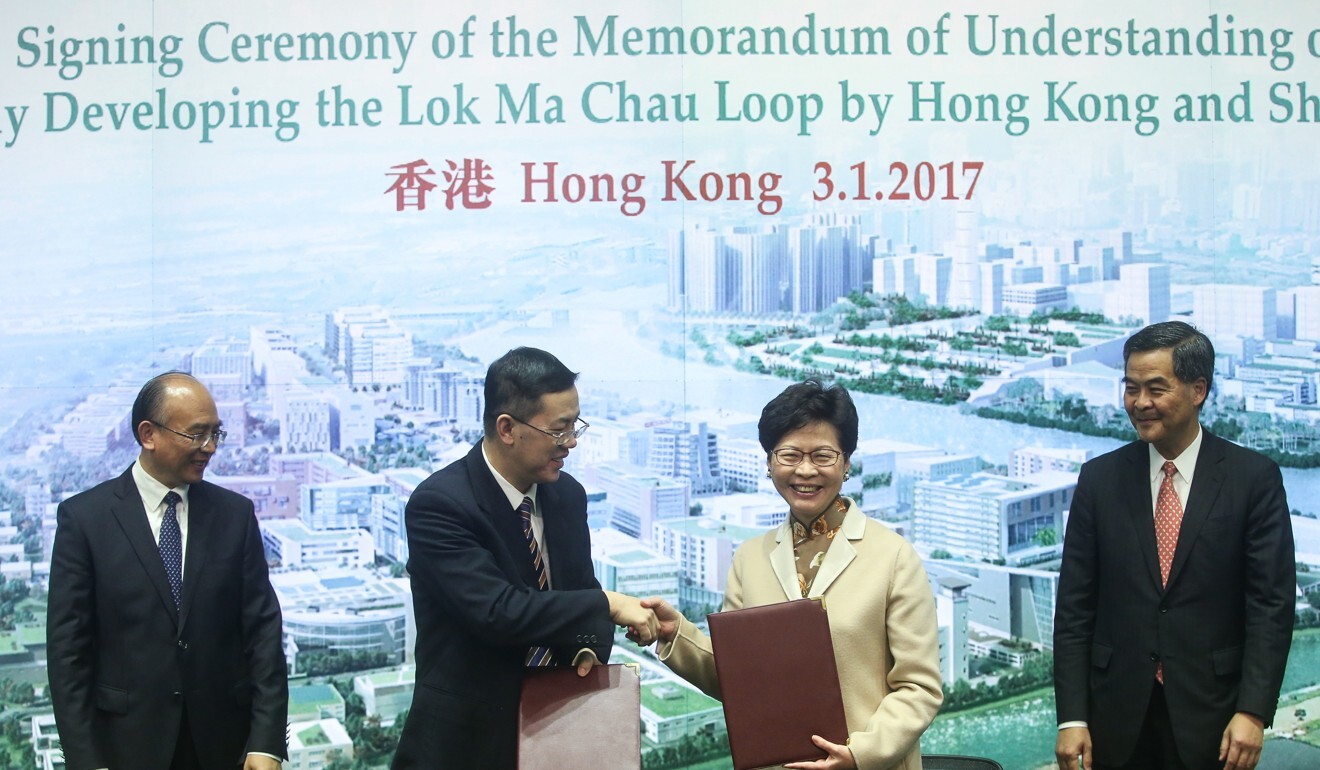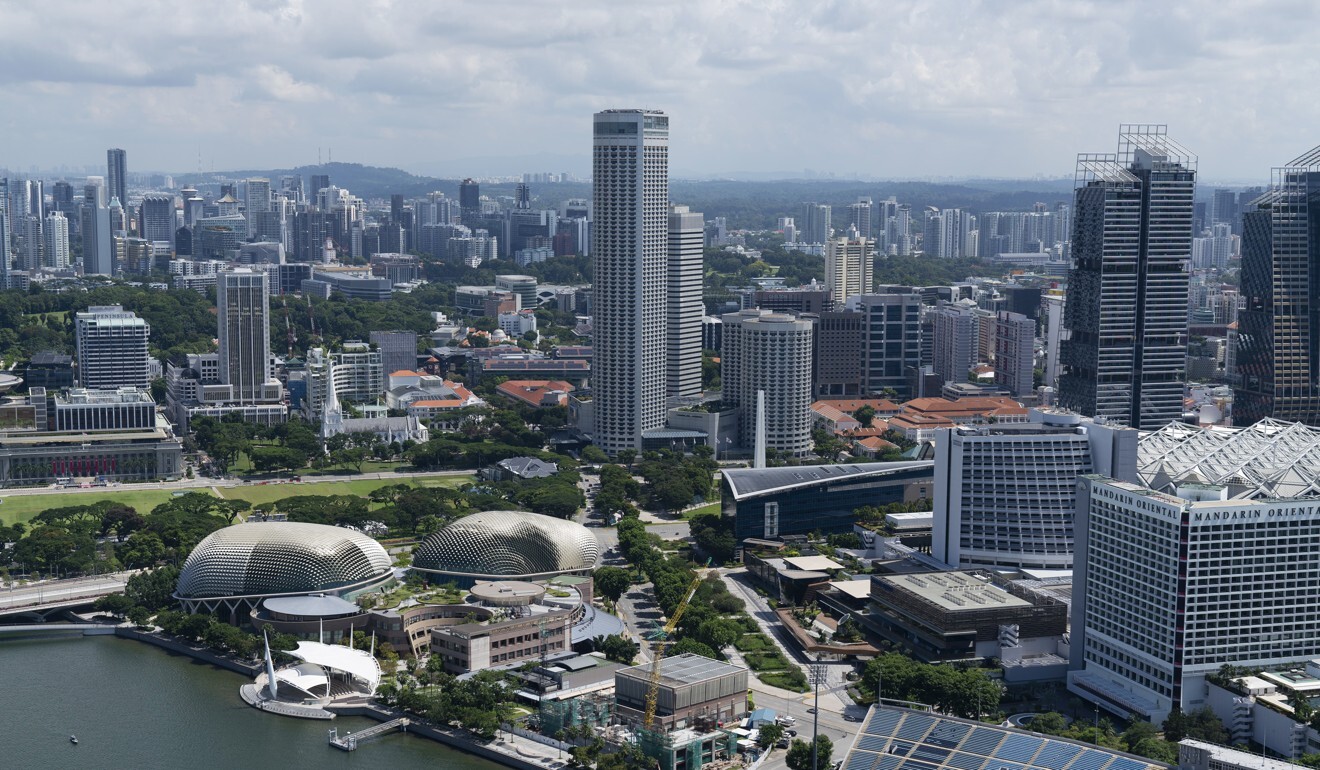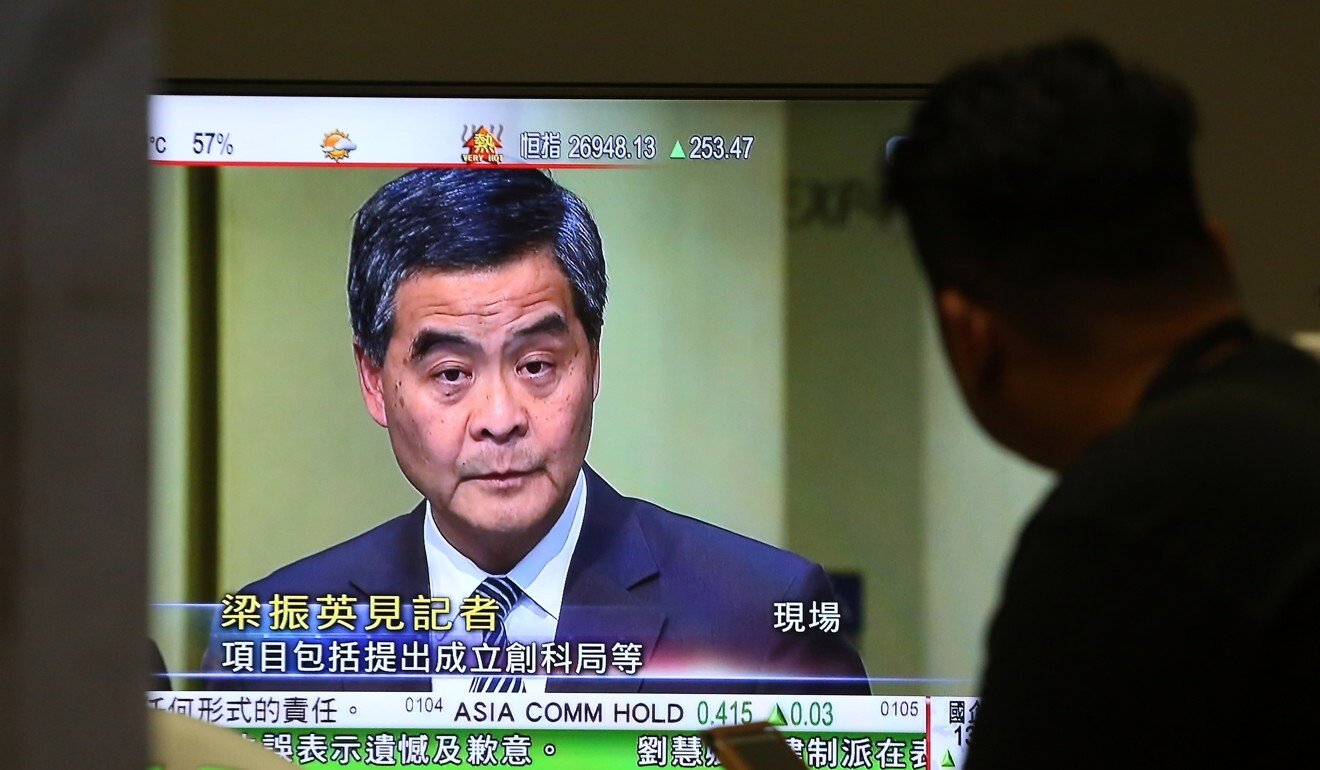
Hong Kong lags behind Singapore in biotech race, but Greater Bay Area could prove its trump card
- Hong Kong’s research and development (R&D) efforts get a chance to catch up with plans for Lok Ma Chau Loop project
- Singapore’s success so far the result of clear vision, funding, support for start-ups, experts say
More than three decades after Hong Kong and Singapore separately embarked on growing biotechnology sectors at almost the same time, their outcomes have proven dramatically different.
Observers say Hong Kong’s efforts have sputtered and lagged behind Singapore’s strides in setting up a range of research institutions, attracting top talent and manufacturers, creating jobs and providing a launch pad for start-ups.
There is now a new urgency for Hong Kong to prove its prowess, given China’s five-year goal of self-sufficiency in technology.

Belatedly, Hong Kong has begun signalling its seriousness in speeding up development of its biotechnology sector, which includes research and development (R&D) in biomedical sciences, pharmaceuticals and the creation of new drugs.
Biotechnology was first identified as a priority in the city’s 2018 budget, which earmarked a massive HK$40 billion (US$5.2 billion) for the Hong Kong Science and Technology Park (HKSTP), the statutory board overseeing the main research hub, Science Park.
Half the amount was for an expansion project, the Lok Ma Chau Loop, Hong Kong and Shenzhen’s joint innovation zone. Slated to open in 2024, it will be nearly four times larger than the 22-hectare (54-acre) Science Park.
People only started realising there was a way to develop this industry in Hong Kong when they saw stronger backing from the government
One major initiative will see the HKSTP lease and manage properties in Futian, Shenzhen – the joint innovation zone – within the next year. The move could encourage Hong Kong firms to expand and build a presence in the bay area.
The question is whether Hong Kong can make up for lost time quickly enough.
When the Hong Kong Institute of Biotechnology was built in 1988, it was just a year after Singapore set up its Institute of Molecular and Cell Biology, the first research centre of its kind there.
And when the Science Park opened in Sha Tin in 2002, expectations were high that it would become an innovation hub hosting technology companies with laboratories and office space.
Yet, growth in the biotech sector remained lacklustre, and developments at the Science Park were slow for years, said Professor Chan Wai-yee, who returned from the United States in 2009 to become director of Chinese University’s biomedical science faculty.
More tech companies likely to list in Hong Kong in next decade, Alibaba’s Joe Tsai says
“At that time, the environment for developing biotech in Hong Kong was not that strong,” said Chan, now the school’s vice-president.
“There was not much government support until a few years ago. People only started realising there was a way to develop this industry in Hong Kong when they saw stronger backing from the government.”
The year the Science Park was created, then Hong Kong leader Tung Chee-hwa merged two government agencies to form the Commerce, Industry and Technology Bureau to push the city’s hi-tech ambitions.
From the start, however, it was not clear if the focus would be developing breakthroughs related to the internet, digital communications, Chinese medicine or something else.
Little was achieved before the bureau was restructured in 2007 and renamed the Commerce and Economic Development Bureau, a change that upset tech experts. It took eight years before technology was back in the spotlight, when then city leader Leung Chun-ying re-established an Innovation and Technology Bureau in 2015.

Chan said that around the same time, there was a shift in the Science Park’s approach, likely due to the appointment of a new chairman and board members in 2014.
“Instead of passively waiting for big pharma to come, the Science Park became more active in recruiting them. That caused a big change in people’s perceptions of the park and marked a beginning, where we saw more well-known scientists arriving,” Chan said.
In 2016, Sweden’s Karolinska Institutet opened a branch in the city, followed by the French Institut Pasteur two years later.
Strategic vision, funding in Singapore
Meanwhile, Singapore’s National Science and Technology Board, created in 1991, was expanded within a decade into the Agency for Science, Technology and Research (A*STAR), tasked with pushing a biomedical science agenda.
It moved aggressively, setting up several world-class research institutes in quick succession, attracting Nobel Prize laureates to work in Singapore, hiring scientists from everywhere while offering generous scholarships to raise a crop of younger PhD-level researchers.
Its multibillion-dollar investments included creating the purpose-built Biopolis, a hub of research centres connected to the city’s universities and business. Singapore also lured international drug makers to set up manufacturing plants, offering attractive tax breaks and grants.
Hong Kong-born chemistry professor Andy Hor Tzi-sum left his job as vice-president for research at the University of Hong Kong (HKU) earlier this year to become A*STAR’s deputy chief executive for research.
China tightens export rules for sensitive tech, boosts power to retaliate against sanctions
Hor, who had previous stints in Singapore, said Hong Kong lacked the kind of strategic planning and hefty investment evident in the city state from the early 2000s.
Singapore demonstrated its commitment through five-year Research, Innovation and Enterprise (RIE) plans that set strategic directions for R&D and made the funding available.
“Such funding injects a lot of resources and confidence into the system and is an important part of Singapore’s success. In Hong Kong, when you are not sure if you can plan ahead, it is very difficult to invest so much in a big business like biotech,” Hor said.
Singapore’s current five-year plan, its sixth and covering 2016-20, has an R&D expenditure of S$19 billion (US$14.2 billion), nearly 10 times more than the first plan.
Observers said that while Hong Kong has the hardware in place and has created one of the world’s largest biotech funding hubs, the sector has suffered for lack of government support and clarity of vision.

As a result, it lags behind Singapore in terms of opportunities for talented scientists, official support for early-stage start-ups, and the pace of commercialisation of research.
Singapore’s R&D expenditure stood at 1.8 per cent of gross domestic product (GDP) in 2018, more than double Hong Kong’s 0.86 per cent that year.
Hong Kong leader Carrie Lam has set the target of doubling R&D spending to 1.5 per cent of GDP by 2022, but observers question if that is still possible with the economy currently in recession.
Hor considers Singapore’s efforts a “very good formula for success”, as its biotech sector has grown to be an important engine fuelling the economy, contributing 4 per cent of GDP today and employing more than 25,000 people.
Manufacturing output for biomedical sciences grew more than fourfold from S$4.8 billion in 2000 to S$$20 billion last year.
A*STAR today has 11 biomedical research institutes at the Biopolis, along with corporate laboratories belonging to industry leaders such as Merck, Procter & Gamble and Novartis.
Established in 2003, the Biopolis is expanding to add space for biomedical science research and offices. By 2022, it will be a 36-hectare (89-acre) hub housing more than 60 biomedical multinationals and start-ups.

There has been progress at Hong Kong’s Science Park as well.
While the Biopolis prides itself on its stellar research institutes, the Science Park has developed a niche as host to more than 900 technology companies. In the past five years, the number of biotechnology companies alone has grown fivefold, from 30 to 150.
Apart from attracting one of China’s renowned research institutes – the Guangzhou Institute of Biomedicine and Health – the Science Park recently established two major research clusters, one in health care and the other in artificial intelligence and robotics.
Hong Kong’s pool of R&D personnel in 2018, inclusive of postgraduates, stood not far behind Singapore’s, at 33,576.
Start-ups need support early
One of Hong Kong’s strengths is its potential talent pool, given the presence of world-class universities such as the University of Science and Technology, HKU and Chinese University, and two reputable medical schools.
However, the biotechnology sector falls short in terms of job opportunities for those students with potential to be leading researchers.
“Only a small fraction of good students, particularly those in science and engineering, are entering the biotech or pharmaceutical industry,” Hor said.
They inject not just capital and GDP into Singapore‘s growth, but also create many high-paying jobs
He cautioned that the lack of jobs could create a vicious cycle in which students shy away from the sciences, resulting in a talent shortage.
Singapore, on the other hand, has plenty of job opportunities for chemistry and biological sciences graduates, thanks in part to the five-year blueprints from earlier years that attracted large pharmaceutical companies to the island state.
“They inject not just capital and GDP into Singapore‘s growth, but also create many high-paying jobs,” Hor added
If there is one area in which Hong Kong has succeeded, it is in creating the world’s second-largest biotech funding hub, with the potential to overtake leader Nasdaq in the next decade.
Its growth was driven by reforms in 2018 that allowed biotechnology firms to sell shares to the public without having a prior revenue or earnings track record. Those reforms were significant for biotechnology firms, which typically require funding to weather the long, costly and risky process of developing their products.

So far, 21 stocks – mostly mainland companies – have gone public under this regime and performed well, according to Hong Kong stock exchange data.
But early-stage biotech start-ups still need more financial support, said Tony Yung Kam-fai, chief executive of Hong Kong-based Take2 Health Limited, which provides early cancer detection services.
“There is a long path from the early stages of a start-up to an IPO. Seven to 10 years would be typical,” he said.
Agreeing, Xiangqian Lin, founder of the Singapore-Boston biotech venture capital firm Esco Ventures X, said the Hong Kong reforms help companies that already have a viable product.
Promising companies at the early stages of product development need incubation support, and in this, he said, Singapore is not short of quality incubators that provide facilities, funding and advice.
Hong Kong researchers in the universities have been doing amazing work, but even if their research is outstanding, it only stays in academic circles, and that isn’t good enough
“Singapore has the edge in early-stage risk capital and a robust early-stage R&D ecosystem,” he said.
Lin said Singapore’s strength in providing support helped Carmine Therapeutics, a genetic medicine start-up his venture capital firm supported.
“Carmine’s technology came out of City University of Hong Kong. We then incubated the company in Singapore, due to the infrastructure and support available, before expanding to the US,” he said.
Explaining why Carmine was incubated in Singapore, he said: “Hong Kong tends to be very China-oriented. Carmine’s technology needed to fly in the US rather than develop in the mainland.”
Yung, the founder of Take2 Health, said Hong Kong is also still in the early stages of commercialisation for biotechnology, and the process of taking inventions from lab to market is slow.
“Hong Kong researchers in the universities have been doing amazing work, but even if their research is outstanding, it only stays in academic circles, and that isn’t good enough,” said Yung, who has been helping professors take their inventions to market for the past seven years.

In April, an incubator for deep tech start-ups called iAXON was launched by HKSTP and HKU. It will provide HKU students space and resources to turn their research into products or results. Currently, there are four projects in the works.
Commercialisation efforts have also been stronger in Singapore, most apparent from the spin-offs from research institutes or universities.
A*STAR’s commercialisation arm, Accelerate, had helped 68 start-ups get off the ground as of 2016.
In 2016, a group of physicians and scientists from A*STAR took their work on late-stage lung cancer into the market, eventually setting up precision medicine company Lucence.
Founder and chief executive Tan Min Han said the company was able to grow thanks to collaboration with public institutes such as the National Cancer Centre and A*STAR to commercialise its new work.
A product or service begins from an innovation phase, then is brought across a development phase. Throughout this process, both government and industry have important parts to play,
“A product or service begins from an innovation phase, then is brought across a development phase. Throughout this process, both government and industry have important parts to play,” Tan said.
With changes in biotechnology moving at breakneck speed, experts were reluctant to predict which city might emerge victorious in the race, adding that their paths were divergent.
A*STAR’s Hor said Singapore’s new biotech niches are in food tech, biologics, personalised medicine and medical technology devices.
Hong Kong has the Lok Ma Chou Loop, which will provide a dedicated space for research and innovation. It might give Hong Kong a leg-up, but only if it has a clear blueprint and is managed well, he said.
How does Hong Kong stay relevant in China’s new technological era? Innovation, analysts say
“Having access to data in a community as big as that will be an important growth driver for Hong Kong’s biotech growth,” Hor said.
The bay area could also make a difference by providing plentiful job opportunities for Hong Kong graduates.
Take2 Health is setting up operations in Qianhai, a free-trade zone in Shenzhen. Its founder, Yung, said Guangdong had reinvented itself to become China’s leading manufacturer of electronic and technological products, and neighbouring Hong Kong was the first to benefit from that transformation.
“When we want to commercialise something, we need a high-quality factory to produce it. You can’t find a better place in the world than Guangdong,” he said.

